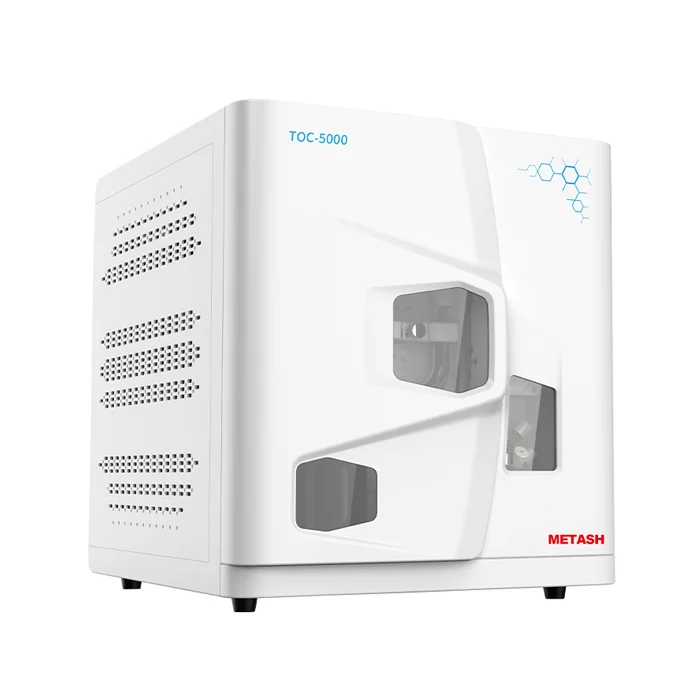- This topic is empty.
-
AuthorPosts
-
29/04/2025 at 15:05 #95076
In the rapidly evolving landscape of renewable energy storage, vanadium flow batteries (VFBs) have emerged as a promising solution for large-scale energy storage applications. Central to the performance and longevity of these batteries is the all-vanadium electrolyte, a critical component whose purity and composition directly influence the battery's efficiency and operational stability. In this blog post, as a precision TOC total organic carbon analyzer exporter, METASH will share the monitoring function of laboratory TOC analyzer in all-vanadium electrolyte to ensure electrolyte quality.
Importance of TOC Monitoring in All-Vanadium Electrolyte
All-vanadium electrolyte serves as the lifeblood of vanadium flow batteries, facilitating the electrochemical reactions that enable energy storage and release. The presence of organic impurities in the electrolyte can have detrimental effects on battery performance. These impurities may interfere with the redox reactions, leading to decreased efficiency, increased energy consumption in the electrolysis process, and reduced electrode activity. Over time, high TOC levels can significantly shorten the lifespan of the battery system. Therefore, precise measurement and control of TOC content are essential for optimizing battery performance and enhancing the economic viability of vanadium flow battery systems.
Laboratory TOC Analyzer in Analytical Technology
The effectiveness of laboratory TOC analyzers in monitoring the TOC content of all-vanadium electrolyte. One such study utilized the TOC 5000 RD analyzer, a state-of-the-art instrument designed to provide accurate and reliable TOC measurements. This analyzer employs a differential method to determine TOC levels by subtracting the inorganic carbon (IC) content from the total carbon (TC) content, thereby isolating the organic carbon fraction. The TOC 5000 RD is equipped with advanced features, including a platinum catalyst, a high-temperature combustion tube, and a non-dispersive infrared detector (NDIR), which collectively ensure high precision and accuracy in TOC measurements.

Experimental Methodology and Results
In the study, the TOC 5000 RD analyzer was used to test the TOC content of all-vanadium electrolyte samples. The samples were prepared by diluting 1 ml and 500 µl of the electrolyte with ultrapure water to a final volume of 100 ml. This dilution step is crucial as it ensures that the samples fall within the measurable range of the standard curves, thereby guaranteeing accurate data. Additionally, dilution helps mitigate the risk of salt accumulation in the analyzer's combustion tube, which can otherwise affect the catalyst's lifespan.
The analysis conditions were meticulously optimized to achieve the best results. The TOC host carrier gas flow was set at 180.0 ml/min, with a pressure of 0.200 Mpa. The TC combustion tube temperature was maintained at 680°C, providing the necessary conditions for complete oxidation of organic compounds. The use of high-purity oxygen (≥99.995%) as the carrier gas ensured a stable and inert environment for the combustion process.
Standard curves for IC and TC were established using sodium bicarbonate and potassium hydrogen phthalate, respectively. The IC standard curve exhibited an excellent linear correlation coefficient (R² = 0.9999), while the TC standard curve demonstrated a perfect correlation (R² = 1.0). These high correlation coefficients indicate that the standard curves are highly reliable and can be used to accurately quantify IC and TC levels in the samples.
The TOC measurements were performed in triplicate for each sample to assess the reproducibility and accuracy of the method. The results showed that the TOC analyzer provided consistent and precise measurements, with minimal variation between replicate analyses. This consistency is crucial for quality control applications, where reliable and repeatable data are essential for making informed decisions.
Conclusion and Future Prospects
The study demonstrates that the laboratory TOC analyzer, specifically the TOC 5000 RD, is an effective tool for monitoring the TOC content in all-vanadium electrolyte. The differential method employed by the analyzer offers a simple, rapid, and accurate means of determining TOC levels. The high correlation coefficients of the standard curves and the excellent reproducibility of the measurements underscore the reliability of this analytical technique.
As the demand for vanadium flow batteries continues to grow, driven by the increasing need for renewable energy storage solutions, the role of TOC monitoring in ensuring electrolyte quality will become even more critical. The use of advanced laboratory TOC analyzers, such as the TOC 5000 RD, will enable manufacturers and researchers to maintain stringent quality control standards, thereby enhancing the performance and longevity of vanadium flow battery systems.
Looking ahead, further research and development in TOC analysis technology may lead to even more sophisticated and efficient methods for monitoring electrolyte purity. This progress will not only benefit the vanadium flow battery industry but also contribute to the broader field of energy storage technologies, helping to pave the way for a more sustainable and reliable energy future.
http://www.metashcorp.com
METASH -
AuthorPosts
- You must be logged in to reply to this topic.
